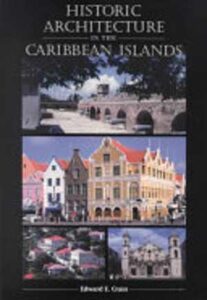نام کتاب: Historic Architecture In The Caribbean Islands
نویسنده: Edward E. Crain
ویرایش: ۱
سال انتشار: ۱۹۹۴
کد ISBN کتاب: ۰۸۱۳۰۱۲۹۳۷, ۹۷۸۰۸۱۳۰۱۲۹۳۳,
فرمت: EPUB
تعداد صفحه: ۲۶۵
حجم کتاب: ۱۸ مگابایت
کیفیت کتاب: OCR
انتشارات: University Press Of Florida
Description About Book Historic Architecture In The Caribbean Islands From Amazon
“For those who are explorers and are curious to know more about the culture of the Caribbean, this book is a useful guide to the significant structures on each island.”–Thomas S. Marvel, architect, Puerto Rico
“A comprehensive, panoramic vision of architecture in this important geographic region.”–Efrain E. Pérez-Chanis, architect and former dean, School of Architecture, University of Puerto Rico
In this abundantly illustrated book, Edward Crain records the rich architectural heritage of the sixteen Caribbean islands. Hundreds of black-and-white and color photographs, most taken by the author, show in detail structures with arresting visual appeal and lasting historic value.
Crain explores the physical, cultural, and political factors that influenced design evolution in the region, including climate, geography, the cultures of early occupants, colonial exploration, military control, immigration, and slavery. He observes that colonial influence dominated architectural development and concludes that designs from the mother countries (Spain, England, France, Denmark, and the Netherlands), while often elegant or delightful, were just as often inappropriate for the tropics.
The Schoelcher Museum in Guadeloupe, for example, embodies the values of French classicism; the Catholic church in Kingston, Jamaica, recalls the Byzantine revival style; the Fox Delicias Theater in Ponce, Puerto Rico, is an example of Art Deco design. Urban design in the Spanish colonies reflects the dictates of the Law of the Indies, which mandated a grid pattern for all streets (even those through hilly terrain) and a central plaza in each town. With its gabled, red-tiled roofs, the capital of Curacao–named Willemstad for Dutch King Willem–is nicknamed “Amsterdam in Miniature.”
“Architecture succeeded when nostalgia was replaced by logic, when a recognition of tropical demands was reflected in the buildings,” Crain writes. When designers realized that the basic function of a Caribbean structure was to offer protection from rain and sun, they introduced such elements as verandas, porches, fretwork, and louvered shutters.
Following architectural development from the time of early Amerindian habitation of the islands up to World War II, Crain groups buildings by type: large and small residences, military facilities, public and institutional structures, and places of worship.
Edward E. Crain works as an architectural educator. When he retired as professor of architecture at the University of Florida, he served as a U.S. Peace Corps volunteer in Jamaica, where he helped set up the Caribbean School of Architecture. He is a member of the American Institute of Architects.
درباره کتاب Historic Architecture In The Caribbean Islands ترجمه شده از گوگل
“برای کسانی که کاوشگر هستند و کنجکاو هستند که در مورد فرهنگ کارائیب بیشتر بدانند ، این کتاب راهنمای مفیدی برای ساختارهای قابل توجه در هر جزیره است.” – توماس اس مارول ، معمار ، پورتوریکو
“یک دیدگاه گسترده و پانوراما از معماری در این منطقه مهم جغرافیایی.” – افرین E. پرز-چانیس ، معمار و رئیس پیشین ، دانشکده معماری ، دانشگاه پورتوریکو
ادوارد کرین در این کتاب کاملاً مصور ، میراث غنی معماری شانزده جزیره کارائیب را ثبت کرده است. صدها عکس سیاه و سفید و رنگی ، که بیشتر آنها توسط نویسندهگرفته شده اند ، ساختارهایی با جزئیات جذابیت بصری و ارزش تاریخی ماندگار را نشان می دهند.
کرین به بررسی عوامل فیزیکی ، فرهنگی و سیاسی م thatثر در تحول طراحی در منطقه ، از جمله اقلیم ، جغرافیا ، فرهنگ اشغالگران اولیه ، اکتشاف استعمار ، کنترل نظامی ، مهاجرت و برده داری می پردازد. او مشاهده می کند که نفوذ استعمار بر توسعه معماری مسلط است و نتیجه می گیرد که طرح های کشورهای مادر (اسپانیا ، انگلیس ، فرانسه ، دانمارک و هلند) ، اگرچه اغلب زیبا یا لذت بخش هستند ، اما برای مناطق گرمسیری نیز نامناسب هستند.
به عنوان مثال موزه شولچر در گوادلوپ ، مظهر ارزش های کلاسیسم فرانسه است. کلیسای کاتولیک در کینگستون ، جامائیکا ، سبک احیای بیزانس را به یاد می آورد. تئاتر فاکس دلیسیاس در پونسه ، پورتوریکو ، نمونه ای از طراحی آرت دکو است. طراحی شهری در مستعمرات اسپانیا منعکس کننده دستورالعمل های قانون هند است ، که الگوی شبکه ای را برای همه خیابان ها (حتی آنهایی که از طریق زمین های تپه ای عبور می کنند) و یک میدان مرکزی در هر شهر را الزامی می کند. پایتخت کوراسائو – به نام ویلمستاد برای ویلم پادشاه هلند – با سقفهای شیروانی و کاشی کاری قرمز ، ملقب به “آمستردام در مینیاتور” است.
کرین می نویسد: “وقتی دلتنگی با منطق جایگزین شد ، زمانی که شناخت خواسته های گرمسیری در ساختمان ها منعکس شد ، معماری موفق شد.” وقتی طراحان دریافتند که کار اساسی سازه کارائیب ایجاد محافظت در برابر باران و آفتاب است ، عناصری مانند ایوان ها ، ایوان ها ، توری و کرکره های مخروطی را معرفی کردند.
بدنبال توسعه معماری از زمان سکونت اوایل جزایر آمریندی در جزایر تا جنگ جهانی دوم ، کرین ساختمانها را بر اساس نوع گروه های مسکونی بزرگ و کوچک ، تاسیسات نظامی ، ساختارهای عمومی و نهادی و عبادتگاهها گروه بندی می کند.
ادوارد ای. کرین به عنوان یک مربی معماری کار می کند. هنگامی که به عنوان استاد معماری در دانشگاه فلوریدا بازنشسته شد ، به عنوان داوطلب سپاه صلح ایالات متحده در جامائیکا خدمت کرد ، و در آنجا به راه اندازی دانشکده معماری کارائیب کمک کرد. وی عضوی از م Instituteسسه معماران آمریکا است.
[box type=”info”]![]() جهت دسترسی به توضیحات این کتاب در Amazon اینجا کلیک کنید.
جهت دسترسی به توضیحات این کتاب در Amazon اینجا کلیک کنید.![]() در صورت خراب بودن لینک کتاب، در قسمت نظرات همین مطلب گزارش دهید.
در صورت خراب بودن لینک کتاب، در قسمت نظرات همین مطلب گزارش دهید.

